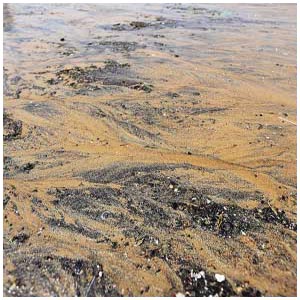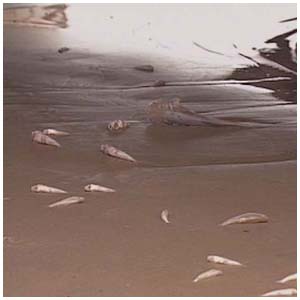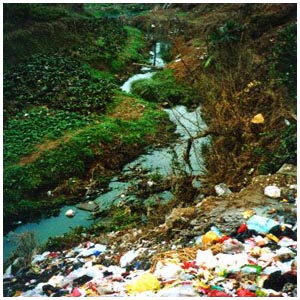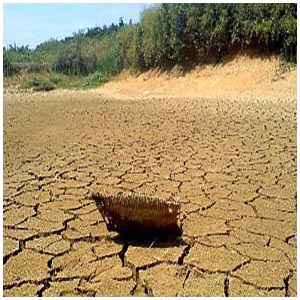| If the river of our hometown has also been polluted, that the bird's home will disappear, the house of fish will not vanish and the clear river will become smelly ditch. We never will see the child’s play and the fishing of the old man. We can no longer wish the clothes or vegetable in the river. The land will dried up not irrigation. |
|
|

 In recent years, the pollution problem of our country has been published by the newspapers and magazines. Now there are the increasing numbers of factories. They have discharged sewage into the river and destroyed ecological balance. In recent years, the pollution problem of our country has been published by the newspapers and magazines. Now there are the increasing numbers of factories. They have discharged sewage into the river and destroyed ecological balance.
 Several students through reading the natural environment books, newspapers, television and surfing the internet, have known that eighty-eight percent of our rivers are polluted and fifty-four percent suffered serious pollution. Several students through reading the natural environment books, newspapers, television and surfing the internet, have known that eighty-eight percent of our rivers are polluted and fifty-four percent suffered serious pollution.
The first,The industrial waste water featured large, wide, complex composition, serious toxicity and difficult to handle and so on is important pollution of water area.
Second ,the agricultural pollution. Pollution sources include animal wastes, pesticides, fertilizers etc. For one ting, organic matter, plant nutrients and pathogenic microorganisms is thick in the pesticides wastewater. For another thing, the content of chemical fertilizer and pesticides is high. We didn’t develop the monitoring of agricultural at present. According to related to information, every year we use 1,1049 million tons of pesticides in the 100 million hectares of cropland and 2.2 million hectares of grasslands. ,the agricultural pollution. Pollution sources include animal wastes, pesticides, fertilizers etc. For one ting, organic matter, plant nutrients and pathogenic microorganisms is thick in the pesticides wastewater. For another thing, the content of chemical fertilizer and pesticides is high. We didn’t develop the monitoring of agricultural at present. According to related to information, every year we use 1,1049 million tons of pesticides in the 100 million hectares of cropland and 2.2 million hectares of grasslands.
It is one of the most serious countries of the soil and water loss in the world. Every year topsoil loss volume is about 5 billion tons. It causes that large pesticides and fertilizer inflow the river, lake, reservoir. With the loss of nutrient element such as the nitrogen, phosphorus and potassium, it makes that two-thirds of the lakes are suffered from the pollution hazard of the different-degrees eutrophication to result in abnormal breed of the algae and microbe. And it makes the transparency of the water and the dissolved oxygen to change which results in the water quality deterioration.
Third, the life pollution. The major pollution sources are all kinds of detergent used in the city life, sewage, garbage, feces and so on. Mostly is non-toxic inorganic salt. In the life sewage, it contains the nitrogen, phosphorus, sulfur and great pathogenic bacteria. According to the survey, the discharge of life sewage in our country can reach 18.4 billion tons.

 The urban infrastructure is a carrier of the industrial construction and restricts the scale and development of industrial construction. For a long time, urban construction of our country unduly reduces the carrier status general adjunct status of industry. The infrastructure development doesn’t coordinate with the population, resources, environment and industrial construction, which leads to long-term overloading of infrastructure. Especially the urban environmental protection infrastructure has been popular in recent years. The sewage treatment capacity of the vast majority of cities can’t meet the actual needs at all. The urban infrastructure is a carrier of the industrial construction and restricts the scale and development of industrial construction. For a long time, urban construction of our country unduly reduces the carrier status general adjunct status of industry. The infrastructure development doesn’t coordinate with the population, resources, environment and industrial construction, which leads to long-term overloading of infrastructure. Especially the urban environmental protection infrastructure has been popular in recent years. The sewage treatment capacity of the vast majority of cities can’t meet the actual needs at all.
  According to the 1999" China Environmental Status Bulletin" showing, our country major seven river systems, lakes, coastal waters and parts of the groundwater are polluted in varying degrees. The river is polluted by organics. The major pollutant is ammonia nitrogen, biochemical oxygen demand, permanganate index and volatile phenols. The characteristic of lakes is eutrophication , and the major pollutional indicators are total phosphorus. total nitrogen, chemical oxygen demand and permanganate index and so on. The pollutional indicators of coastal waters are inorganic nitrogen, active phosphate and heavy metals. These factors form that the water environmental problem features wide coverage, damage to power and difficult to treatment. Problems of the water environment in China are caused by many factors, but the main is human subjective factors. For a long time, the economic growth pattern is extensive and the enterprises pursue economic benefit. So we neglect the environmental benefit and ecological benefit According to the 1999" China Environmental Status Bulletin" showing, our country major seven river systems, lakes, coastal waters and parts of the groundwater are polluted in varying degrees. The river is polluted by organics. The major pollutant is ammonia nitrogen, biochemical oxygen demand, permanganate index and volatile phenols. The characteristic of lakes is eutrophication , and the major pollutional indicators are total phosphorus. total nitrogen, chemical oxygen demand and permanganate index and so on. The pollutional indicators of coastal waters are inorganic nitrogen, active phosphate and heavy metals. These factors form that the water environmental problem features wide coverage, damage to power and difficult to treatment. Problems of the water environment in China are caused by many factors, but the main is human subjective factors. For a long time, the economic growth pattern is extensive and the enterprises pursue economic benefit. So we neglect the environmental benefit and ecological benefit
|
|
|
|